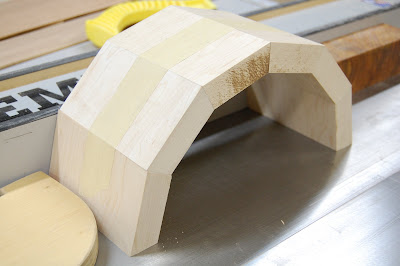 What is a stacked ringed segmented vase you ask? That's a great question as this vase is an example of such construction. OK, so now you want to know how many pieces (segments) are there in this vase? There are 180 segments which make up the vase and the woods involved are maple, walnut, cherry, & white oak. Each ring has 12 segments and there are a total of 15 rings.
What is a stacked ringed segmented vase you ask? That's a great question as this vase is an example of such construction. OK, so now you want to know how many pieces (segments) are there in this vase? There are 180 segments which make up the vase and the woods involved are maple, walnut, cherry, & white oak. Each ring has 12 segments and there are a total of 15 rings.I was inspired to create this vase when I first saw the works of Lincoln Seitzman as I was browsing the web one evening a few years back. As it turns out Lincoln was a pioneer in the world of segmented woodturning back in the 1980's. I remember the effect he had on me when I came across his works. I was totally puzzled as to how he went about creating his works of art. Since that time I have learned some of the processes that Lincoln used and I hope that I can share some of these practices with anyone who cares to learn.
Woodturnerpro is the software that I used to design the vase and this software also produced a cutting list for me to follow. Since there are 15 rings of varying size I needed to know the dimensions of the woods that I would be employing. The software also gives you the necessary angles needed for the cuts...(15 degrees in this case.)
The Wixey angle gauge is very helpful when it comes to setting up the saw for cutting. Accuracy is imperative from the beginning til the end. You'll notice the a caliper employed as well.
In this picture you can see a piece of maple that will be used to form a ring. The first cut of 15 degrees has been made and is butted against a stopblock that has the same 15 degrees. The software also gives you the length of cut needed. Once the segment is cut, remove the segment and then flip the length of maple over 180 degrees so that it's 15 degree angle butts up against the stopblock. Continue this process until you have a total of 12 segments. That's good for one ring.



























.jpg)